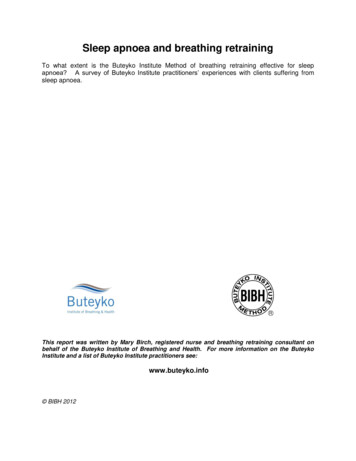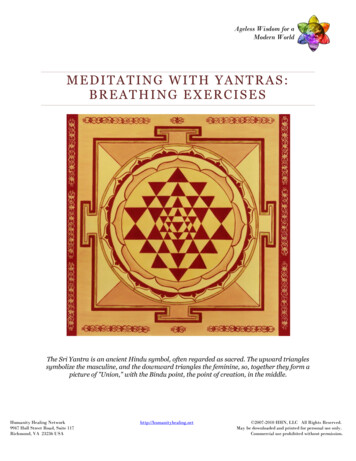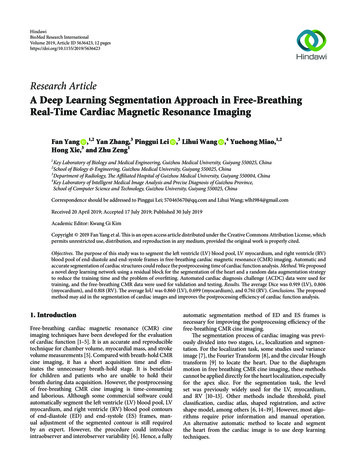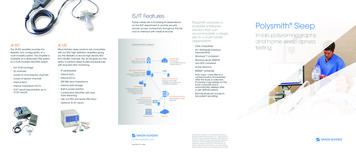
Transcription
Sleep apnoea and breathing retrainingTo what extent is the Buteyko Institute Method of breathing retraining effective for sleepapnoea? A survey of Buteyko Institute practitioners’ experiences with clients suffering fromsleep apnoea.This report was written by Mary Birch, registered nurse and breathing retraining consultant onbehalf of the Buteyko Institute of Breathing and Health. For more information on the ButeykoInstitute and a list of Buteyko Institute practitioners see:www.buteyko.info BIBH 2012
ContentsAbstract. 3Buteyko Institute and the Buteyko Institute Method (BIM) . 4Sleep-disordered breathing . 4Research on disordered breathing patterns . 5Sleep apnoea – aetiology and pathophysiology . 5Hyperventilation as a contributory or causal mechanism in sleep apnoea . 6Proposed mechanisms using breathing retraining to alleviate sleep apnoea . 8BIBH 2010 sleep apnoea survey . 8Literature review . 8Survey sample . 8Figure 1: Total no. of sleep apnoea clients taught by survey respondents. 9Sleep apnoea diagnoses. 9BIM survey questionnaire . 9Improvements in sleep, health, concentration and energy levels .10Improvements in snoring, headaches, period limb movements, obesity .10Client assessment and monitoring .11Figure 2: Client assessments methods used by survey respondents .11Unexpected benefits arising from BIM courses .12Sleep studies showing before and after BIM breathing retraining .12Challenges in teaching BIM.14Non-adherence/Non-compliance with current therapies .14Study Limitations.16Conclusions .16Acknowledgements .17Disclosure .17Endnotes.182
AbstractThis report analyses information from a survey on breathing retraining in relation to sleepapnoea, conducted in 2010 on behalf of the Buteyko Institute of Breathing and Health (BIBH).The aim of the BIBH survey was to determine how effective the Buteyko Institute Method (BIM)of breathing retraining is for clients suffering from sleep apnoea. Information obtained from thissurvey was based on the experiences of Buteyko Institute practitioners and covered over11,000 clients with sleep apnoea who had been taught the method.The majority of practitioners who responded estimated that following BIM breathing retrainingcourses:Over 95 percent of clients with sleep apnoea had improved sleep.Approximately 80 percent of clients had been able to cease use of their CPAP machineor oral appliances.Symptoms such as snoring, headaches, restless legs, low concentration levels anddecreased energy levels also improved in the majority of clients.In addition, this report analyses the relationship between disordered breathing patterns andsleep apnoea, and suggests that hyperventilation may be a key factor in sleep apnoea aetiologyand pathophysiology.While the outcomes from the BIBH survey are based on anecdotal evidence, the ButeykoInstitute considers that the method warrants further study and contends that breathing retrainingusing the Buteyko Institute Method may offer an effective, safe and acceptable option for peoplewith sleep apnoea.3
Buteyko Institute and the Buteyko Institute Method (BIM)The Buteyko Institute of Breathing and Health is an Australian-based not-for-profit professionalorganization founded in 1996, which regulates and represents practitioner members in Australiaand overseas. Before becoming accredited by the BIBH, practitioners undergo extensivetheoretical and practical training and when accredited as practitioner members, are required topractise in accordance with the Buteyko Institute codes and standards.1 The Buteyko InstituteMethod of breathing retraining taught by BIBH practitioners is based on the work of Russianphysiologist and medical doctor, the late Professor Konstantin Pavlovich Buteyko.The objective of the BIM method of breathing retraining is to normalize the breathing pattern inevery respect. It incorporates client education and breathing retraining exercises which aim to:improve the breathing volume, rate, and rhythmimprove posture and promote correct use of the diaphragm and breathing musclesrestore comfortable nose-breathing.BIM courses also incorporate lifestyle changes and provide guidelines and strategies aimed atimproving sleep and eliminating symptoms. BIM courses generally consist of five consecutivedaily 90 minute sessions and also include follow-up reviews. The breathing retraining exercisesare performed regularly on a daily basis until breathing is improved, symptoms are eliminatedand normal breathing patterns become automatic.The Buteyko method was developed in Russia in the 1950s and was endorsed as a mainstreamtherapy for asthma in the Soviet Union in 1983. Following its introduction to Australia in 1990,the method was taught mainly to people with asthma. However, in the past decade, increasingnumbers of people with sleep apnoea in Australia and overseas have attended courses inbreathing retraining using the Buteyko Institute Method.In 2010, in light of the increasing numbers of people with sleep apnoea attending Buteykocourses during the preceding decade and the lack of clinical trials on the topic, the BIBHdecided to conduct a survey on sleep apnoea, as a preliminary to possible clinical trials.Throughout their years of experience in teaching the method to people with sleep apnoea,Buteyko Institute practitioners have accumulated a large body of knowledge on this topic.Therefore, this survey was based on the retrospective experiences of Buteyko Institutepractitioners who had taught the method to clients with sleep apnoea. The objective of thissurvey was to determine how effective the Buteyko Institute Method is for people with sleepapnoea from the perspective of BIBH practitioners.Sleep-disordered breathingCentral sleep apnoea (CSA) and obstructive sleep apnoea (OSA) are considered to be twoforms of sleep-disordered breathing (SDB). Obstructive sleep apnoea, the most common formof sleep apnoea,2 is a condition characterized by repetitive episodes of complete or partialupper airway obstruction during sleep (i.e. apnoea or hypopnoea), producing repetitive episodesof arousal or semi-arousal from sleep and hypoxemia (reduced oxygenation).3 Central sleepapnoea is characterized by the periodic occurrence of apnoea in association with loss ofventilatory motor output.4 Sleep medicine has only recently been recognized as a specialty ofmedicine and the widespread use of polysomnography (sleep studies) to diagnose sleepapnoea is also relatively recent.5Estimates of the number of people suffering from obstructive sleep apnoea vary. An Australianpublication by the National Health & Medical Research Council (NHMRC) from 2000, quotes4
one source as estimating that 24 percent of males over 55 and 6 percent of females over 55 inAustralia suffer from obstructive sleep apnoea.6Research on disordered breathing patternsFrom his clinical practice and extensive research, Professor Konstantin Buteyko found thatdisordered and abnormal breathing patterns were characteristic in people with asthma, sleepdisturbance and many other common health conditions. Chronic hyperventilation was the mostconsistently found overriding breathing pattern disorder. Intermittent hyperventilatory breaths(in the form of sighing, yawning, and gasping for example) were also common, often appearingin addition to a pattern of chronic hyperventilation. Hyperventilation can be defined as:“A pulmonary ventilation rate that is greater than metabolically necessary for theexchange of respiratory gases. It is a result of an increased frequency of breathing, anincreased tidal volume or a combination of both, and causes an excessive intake ofoxygen and the blowing off of carbon dioxide.” 7Professor Buteyko found that hyperventilation caused or contributed to several conditions,including asthma and “sleep disturbance”.8 Professor Buteyko’s clinical research wasconducted in the Soviet Union from the 1950s to the 1980s (before sleep medicine becamewidespread as a medical specialty) and some of his work has not yet been translated fromRussian. A chapter of a book relating to Professor Buteyko’ work (The Buteyko Book,translated from Russian) refers to a study of people with “sleep disturbance”. Forty-one peoplewere listed as suffering from sleep disturbance. Following breathing retraining, in 26 thecondition is noted to have disappeared, in 13 it decreased and in two no change is reported.9The first clinical trial of the Buteyko method in the Western World was conducted in Australiaand published in the Medical Journal of Australia in 1998. This blinded randomised controlledtrial showed that the asthma patients studied were significantly hyperventilating. At the start ofthe trial, the average minute volume was 14 litres per minute compared with the normal range offour to six litres per minute. Three months following a Buteyko course, minute volume in theButeyko group was reduced to 9.6 litres per minute, and this reduction correlated with asignificant reduction in the need for asthma medication.10 A subsequent Australian study in2004 found that end-tidal carbon dioxide (ETCO2) in asthma patients increased as a result ofthe Buteyko method11 suggesting that hyperventilation had decreased as a result of breathingretraining using the method.Professor Buteyko’s findings on hyperventilation in association with numerous symptoms andconditions are supported by the work of expert clinicians. Buteyko found that hyperventilationwas not always apparent – either to the patient or to the doctor – and hence he called thecondition “hidden hyperventilation”. Respiratory physician and pioneer on hyperventilation, thelate Dr Claude Lum, also maintained that hyperventilation was not always evident and in fact, hereferred to classic or obvious hyperventilation as “ the tip of the iceberg”, occurring in only onepercent of cases.12 World-renowned psychologist, Professor Robert Fried,13 also describes theeffects of hyperventilation and associated illnesses and conditions.Sleep apnoea – aetiology and pathophysiologyDespite extensive clinical research within the past thirty years, the aetiology of sleep apnoea isunknown. Considerable research has focused on the possible causes of sleep apnoea,including altered sleep architecture, obesity, and underlying anatomical and physiologicalanomalies that might be linked to apnoea. Experts acknowledge that the pathophysiology ofsleep apnoea is complex and there may be considerable variations in contributing factors. For5
example, reduced upper airway dimensions and altered tissue mechanics are considered toplay a part but do not suffice to explain the upper airway collapse which occurs during OSA,according to Gaudette and Kimoff published in the European Respiratory Society Monograph in2010.14Proponents of the breathing retraining approach to the management of sleep apnoea contendthat as sleep apnoea is characterised as sleep-disordered breathing, its aetiology is more likelyto be found in association with abnormal or disordered breathing patterns, specifically thoseassociated with intermittent or chronic hyperventilation. Signs and symptoms of breathingpattern disorder which may be indicative of chronic or intermittent hyperventilation in associationwith sleep apnoea include:mouth-breathingaudible breathingfeeling short of breath or unable to get enough airlarge chest excursionirregular or erratic breathing patternselevated respiratory rate*increased tidal volume*increased minute volume when not in apnoea or hypopnoea*decreased end-tidal carbon dioxide levels when not in apnoea or hypopnoeaupper chest breathing patterna daytime breathing pattern characterised by uneven-sized breaths, apnoea, andfrequent yawning and sighinga night-time breathing pattern characterised by uneven-sized breaths, apnoea,hypopnoea, gasping, snoring and
Professor Buteyko found that hyperventilation caused or contributed to several conditions, including asthma and “sleep disturbance”.8 Professor Buteyko’s clinical research was conducted in the Soviet Union from the 1950s to the 1980s (before sleep medicine became











